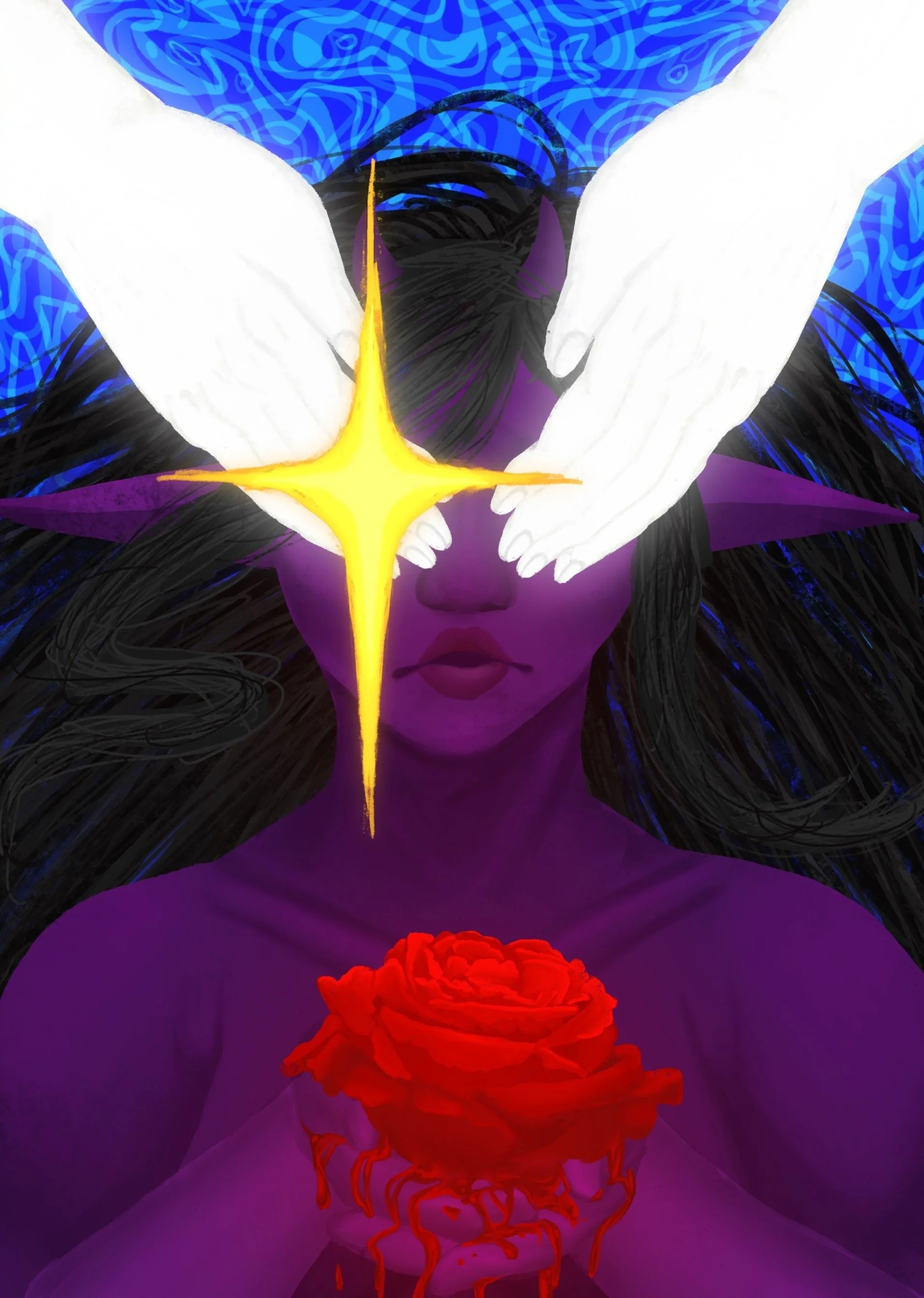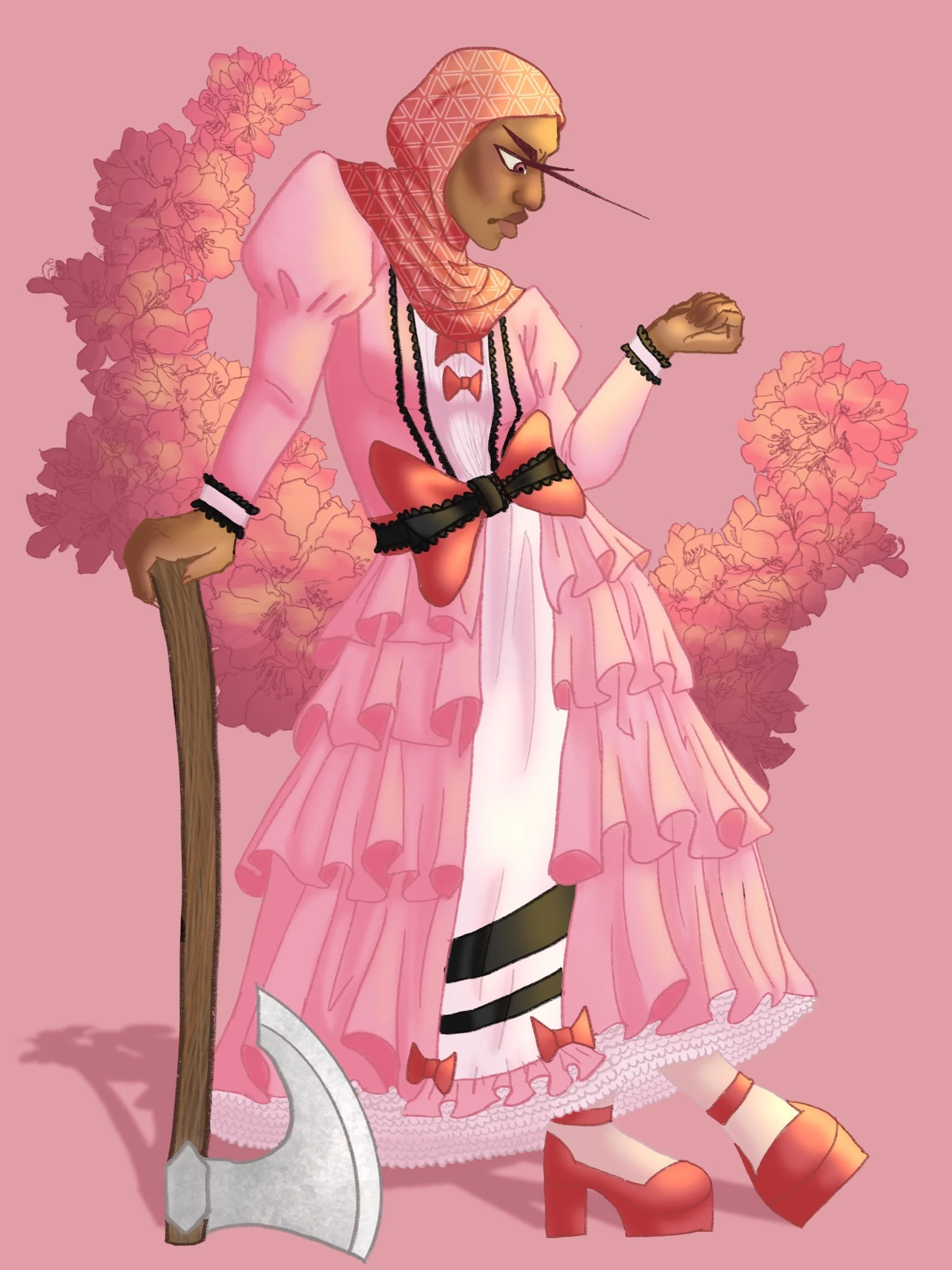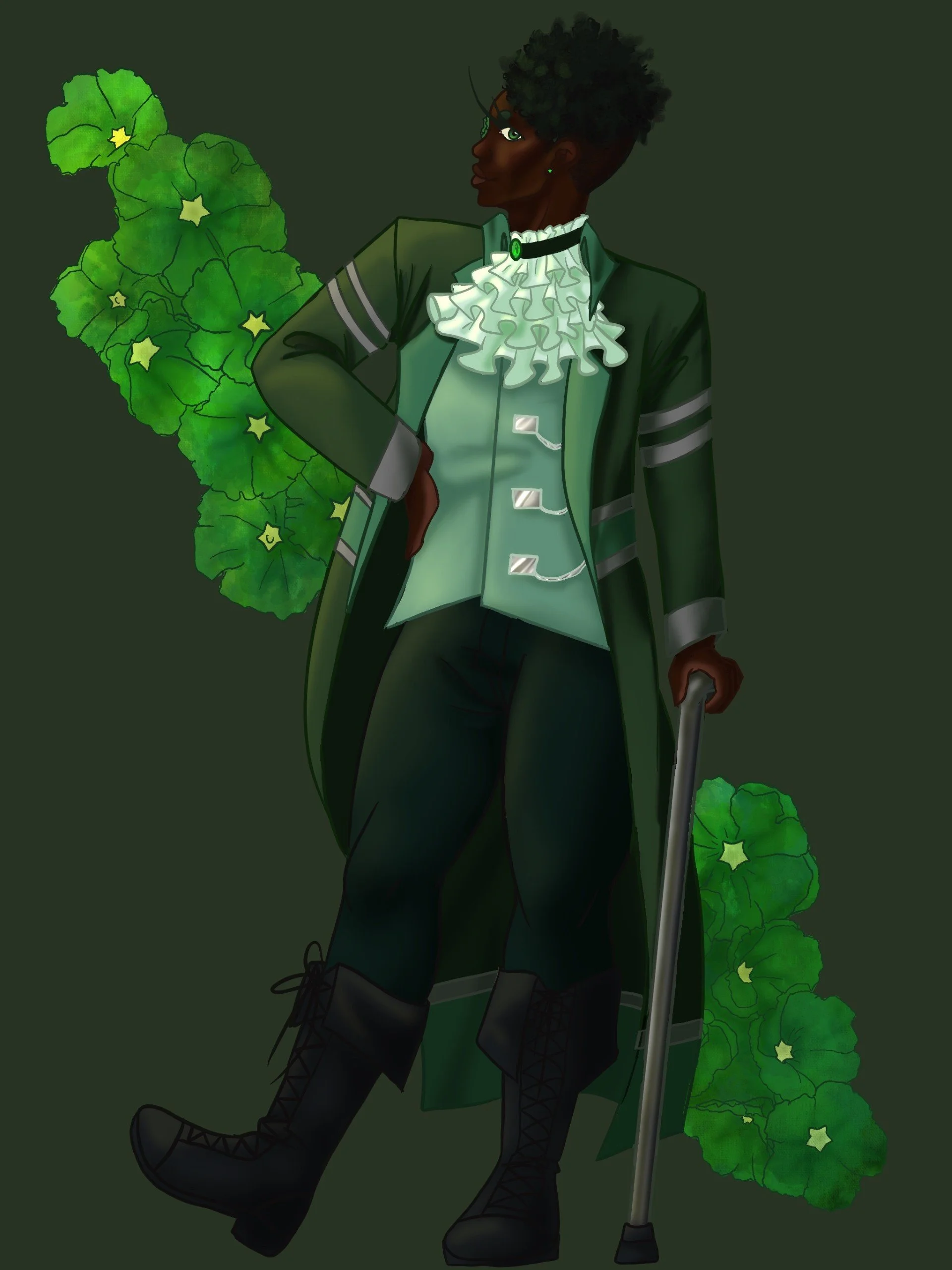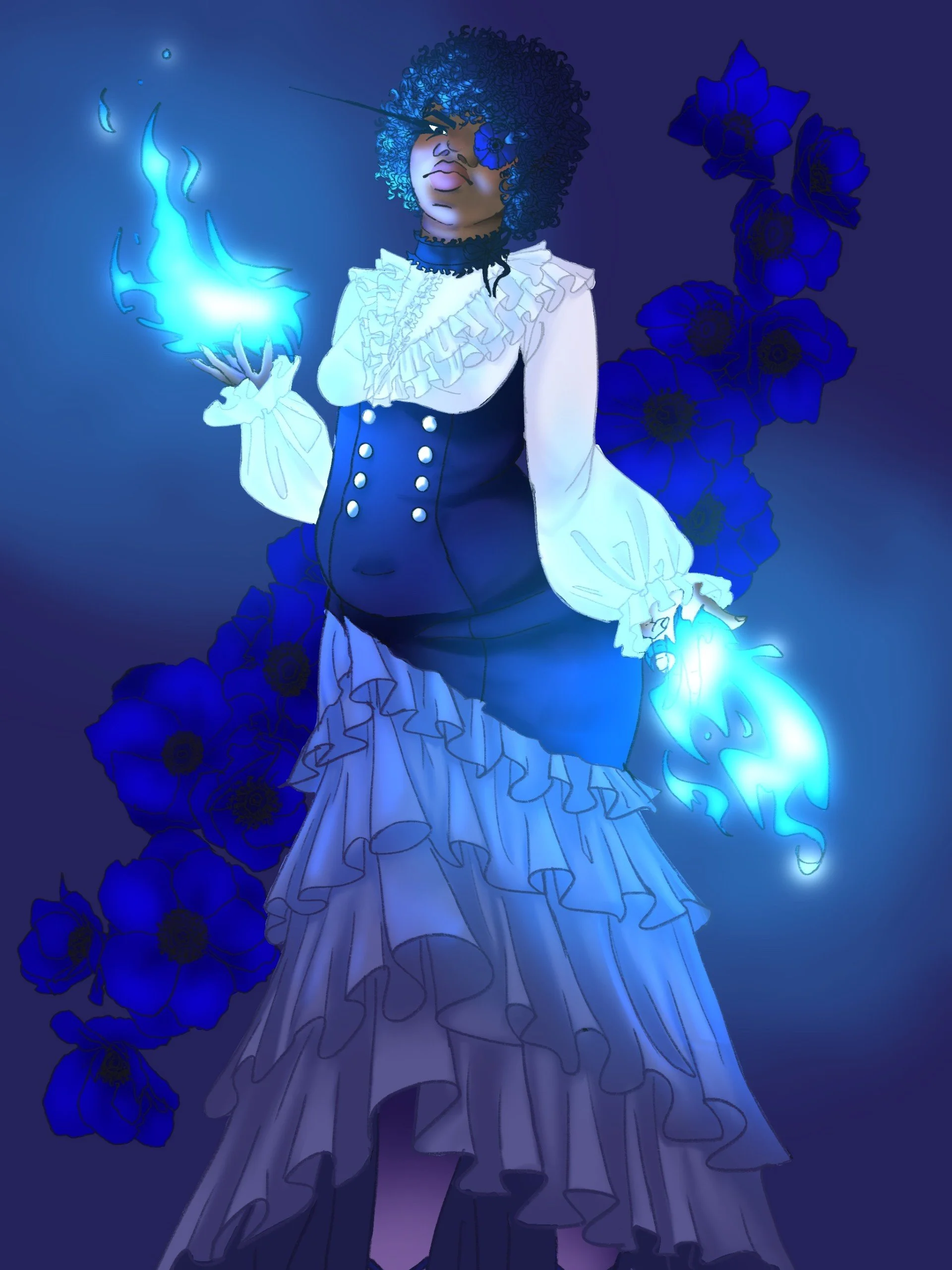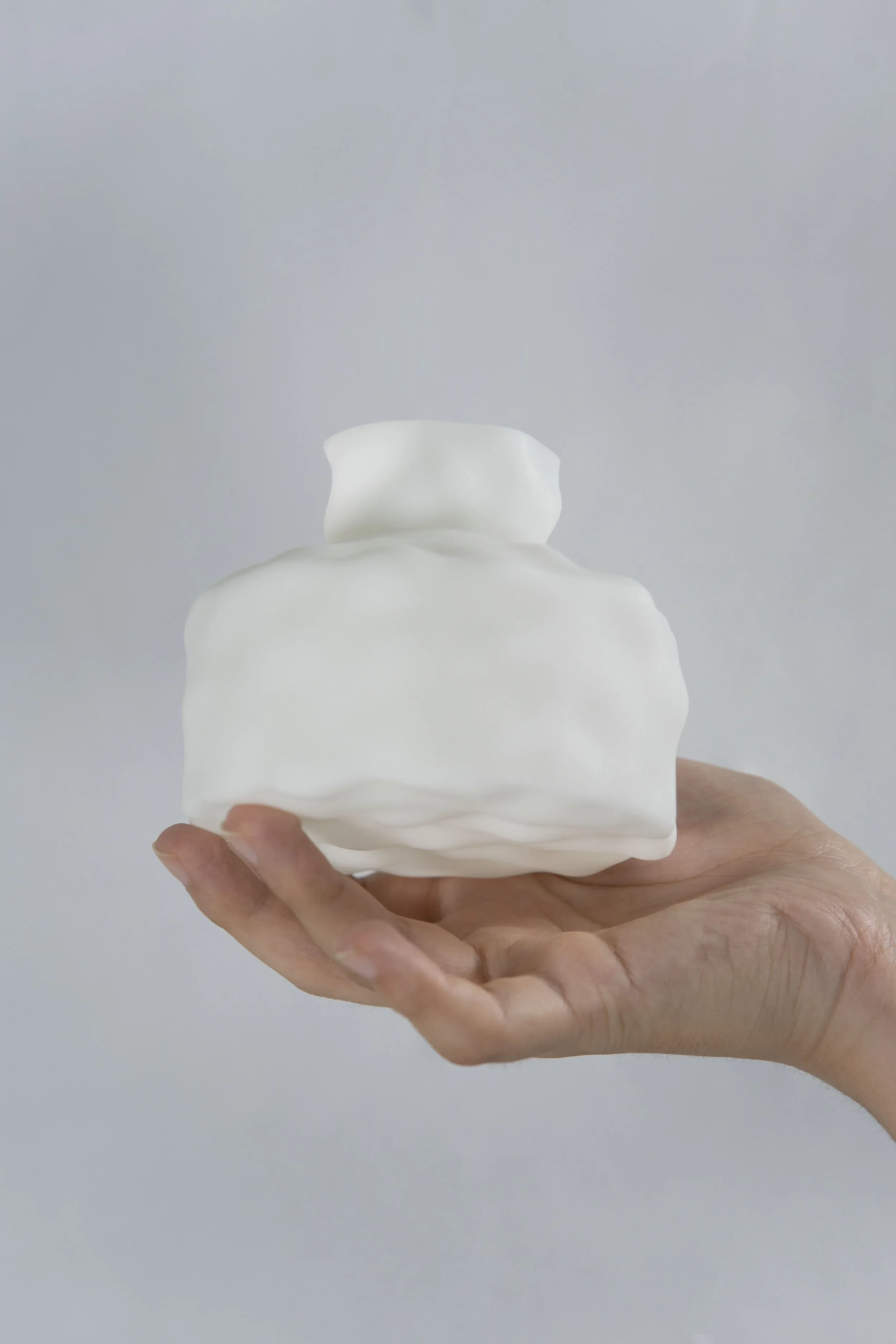10 Questions with Emil Stoetzer
Emil Stoetzer - Portrait
Emil Stoetzer (they/them) is a multidisciplinary artist based in London, Ontario, Canada. They are a queer, neurodivergent artist whose work focuses on the lived queer experience, intersectional feminism, and socio-political happenings through fictional narratives and characters.
Stoetzer’s artistic practice focuses on fictional characters, story-telling, and socio-political issues through an intersectional feminist lens. As a queer, neurodivergent person, they must acknowledge the privileges they have and lack. Emil Stoetzer must also critically analyze how their privileges intersect with various other identities within society and know what they can and cannot speak on. Power is a multifaceted, complex issue that their work delves into via overt messages or is integrated into the themes of the work.
In their work, they aim to inflict large-scale change through activism and small-scale change through influencing someone’s perspective. The theoretical framework of Clay Sreakley’s “All artwork is inherently political” rings true. All artwork is political because the artist, a human being, is inherently political. One must exist to create art, and by existing, one has or has been influenced by politics. Being ‘apolitical’ is a privilege and a political identity in itself. Stoetzer uses art as a tool to convey passion and connect themselves with others on multiple levels. They aim to convey power through representation, stories, and designs in their work and through these themes, they aim to start conversations that can make people uncomfortable.
Vir-Sy Poster, digital, 29.7x42cm, 2024 © Emil Stoetzer
INTERVIEW
Let's start from the basics. Can you share a bit about your background and what first drew you to making art?
I was born and raised in London, Ontario, Canada, and have been artistically compelled since a young age. Looking back, it was due to being autistic and struggling to communicate and connect with others. Doing art was how I expressed myself, my feelings, and how I stayed sane. I started taking art more seriously around age 12 when my best friend got me into anime again. When puberty hit and my queerness was becoming more obvious, drawing was how I self-soothed, as well as expressed my admiration for female characters. As my mental health and illnesses worsened in my teenage years, art kept me alive.
How does your identity as a queer, neurodivergent person shape the way you approach your work?
As I mentioned, my relationship with art is intrinsically tied to my personal identity and experiences. My identities have shaped not only my own love of art but also my perception of it. In the present, I struggle with connecting to and communicating with my peers. Sometimes, it feels like I have so much to say, express, and create, but no one is willing tolisten. Like I am nothing. I want my experiences and my art to help other people not feel this way – or at least feel seen. If my work can touch one person's heart and make a person feel seen or heard, then it is worth it.
Furthermore, my experiences with marginalized identities have made me more aware of and sympathetic to others with similar or vastly different experiences of marginalization. I am no saint, nor will I pretend to be. But my queerness and neurodivergence have allowed me to learn to deconstruct systems of power that affect myself, others, and more.
Five, digital, 17.3x23cm, 2024 © Emil Stoetzer
One, digital, 17.3x23cm, 2024 © Emil Stoetzer
Four, digital, 17.3x23cm, 2024 © Emil Stoetzer
Seven, digital, 17.3x23cm, 2024 © Emil Stoetzer
Storytelling and fictional characters are central to your practice. What inspires the narratives you create?
The narratives I create are all based on reality, as all fiction is. Inspired by my own experience - each character and narrative I create has some of myself in it, how could it not? I also strive to focus on stories and narratives of reality that I cannot relate to. I have many privileges, mainly that of being middle-class and white in Canada, but these privileges are not an excuse for ignorance, not when I can use these privileges to highlight the narratives of other marginalized peoples.
The world we live in is full of strife and yet, there is hope. I see the horrors of genocide and more across the world in Palestine, in Congo, and in Canada. I see people turn away. I can see myself wanting to turn away. But I refuse. These narratives, those of hope, persistence, and survival of peoples whose lives are being oppressed, obliterated, and forgotten, are what matter. I can use my privileges and my art to help with the aid of others. That is what inspires me.
Your work often addresses socio-political themes through an intersectional feminist lens. How do you decide which issues to explore?
The issues I tend to explore often fall upon what I can and cannot speak on, as well as what I am or am not educated on. I can directly speak about my own experiences, but I want to make sure that I, and an audience, understand that my experience is not the only experience of those with my identities. Representation and identities are not monolithic.
I want to continue to try my best to speak on as many issues as possible to educate myself as well as others. It is less about deciding on a specific issue and more about larger, overarching themes that have specific relations. For example, my videogame project, Vir-Sy, touches on a multitude of issues such as racism, queerphobia, colonialism, nihilism, ableism, etc., but the core of the project revolves around finding reasons to stay alive as the meaning of life. While one character's arc may delve into the specifics of a socio-political topic and have real world parallels, another may tackle a completely different combination of issues because every person has their own experience.
I also want to make sure that I collaborate with and learn from people with different experiences than my own, credit these people, and provide resources and (hopefully in the future) profits towards them to ensure that I am not using the struggles of another to profit for myself.
Eight, digital, 17.3x23cm, 2024 © Emil Stoetzer
What role does activism play in your creative process? Do you see your art as a form of direct action?
I believe that activism is inherent to my creative process because that is what I am passionate about. It doesn't have to be a direct call to action, though I do that as well, but doing research, collaborating with, and representing marginalized peoples is, in my opinion, a form of activism. The horrors of reality do affect my creative process, as reality directly influences fiction, but even more so, the persistence of love and humanity inspires me even more so. Even in the worst of times and the worst of scenarios, I believe that there is always beauty and hope in trying – that is what inspires me.
This being said, I do not consider art a direct call to action all the time. I believe it can be an excellent method of direct action and act as a stepping stone towards direct action. Sometimes, money talks more than art does. Sometimes, it's going to a protest, calling a representative, boycotting, protecting others, spreading information, educating yourself, joining a riot, etc.
You've mentioned the idea that "all artwork is inherently political." How does this perspective influence the way you create and share your work?
This is a core philosophy of mine. Mainly because all people are inherently political, thus the art people create is such. Artists who hide behind the thin veil of being 'apolitical' are masking their apathy and compliance to harm. The act of not choosing, of not speaking up, is itself a choice. Just because one is privileged enough to pretend to be 'apolitical' does not mean they are free of politics.
I believe in honesty and that includes admitting to privileges and ignorance, especially my own. If I am unaware of an issue, I want to learn – I want to do better. I want to speak up and help those around me. I want to help myself become a better person, too. My work is political because I am human.
Power and privilege are complex topics in your work. How do you navigate representing these themes responsibly?
That's what I ask myself as well. How does one navigate their own blind spots? Their own privileges? I think whatmatters is that people, including myself, try. I'd rather try, fail, and learn to do better than remain ignorant, biased, and power-hungry. For example, as a white person, I cannot speak on or for people of colour. However, I can use my skills and resources to educate myself and others, work with and for POC, and donate time and, if possible, money to communities of colour.
The main character in the Vir-Sy game, the purple-skinned one, acts as a player insert. They are ignorant of the way the world works and, compared to the other characters, seem to be in a different world entirely! I want to use this idea to examine the purple-character's 'white' privilege as well as deconstruct narratives around POC characters in video games. In the first game I made, Zero, a Black Woman, plays into a trope of a magical Black person who gives the character knowledge. However, the game will further deconstruct this racist trope as it progresses, fleshing out Zero as an individual and, most importantly, her own main character. I think it's also important to not pretend that fantasy racism is the same as real-life racism, as an example. Orcs discriminating against dwarves cannot be an allegory for white people discriminating against Sudanese people because it lacks nuance, and more importantly, are different species! Human racism is exactly that – human.
Two, digital, 17.3x23cm, 2024 © Emil Stoetzer
Zero, digital, 17.3x23cm, 2024 © Emil Stoetzer
How do you hope viewers respond to your work, especially when it makes them uncomfortable?
I hope that viewers engage in reflection – reflection on the self and their own situational privileges or lack thereof. I aim to make the comfortable uncomfortable, and all that. I want to confront people who have privileges or notions of oppression and challenge them. I want to make people use media literacy and confront themselves. I want to engage in critical thinking skills. I want to call out systems of oppression and one's participation within them. I hope that viewers will allow me to do so.
I recall being in a university class wherein I brought up my experience with aphobia and self-harm, as well as other'saspect (asexual spectrum) experiences, only to be met with silence. While describing what my short comic was about, I was met with nothing. I thought people hated me, my message, and my art. However, after talking to a friend and classmate, she assured me that many people were blown away by my work but just didn't know what to say. This experience taught me that confronting things head on and directly can make people uncomfortable, too.
Are there any upcoming projects or ideas you're excited to explore in the near future?
Yes! During my time doing my master's degree at OCAD University, I will continue to build upon and expand my Vir-Sy videogame project. This includes creating more game chapters, exploring new mediums, engaging with different communities, and connecting stories together. I am also planning on making more comics, expanding my small business, and learning more animation skills.
And lastly, where do you see yourself and your work in five years from now?
I honestly struggle to see myself in the future, as I do not know what will come. I'd like to graduate from my master's program and focus on developing my art career further, whether it be through grants, video games, jobs, or personal! I think holding expectations for the future can be tricky as a disabled person. Sometimes, my goals are over-ambitious and other times, societal norms and expectations can weigh me down. Regardless, I want to be happy in the future, too!
Artist’s Talk
Al-Tiba9 Interviews is a promotional platform for artists to articulate their vision and engage them with our diverse readership through a published art dialogue. The artists are interviewed by Mohamed Benhadj, the founder & curator of Al-Tiba9, to highlight their artistic careers and introduce them to the international contemporary art scene across our vast network of museums, galleries, art professionals, art dealers, collectors, and art lovers across the globe.



